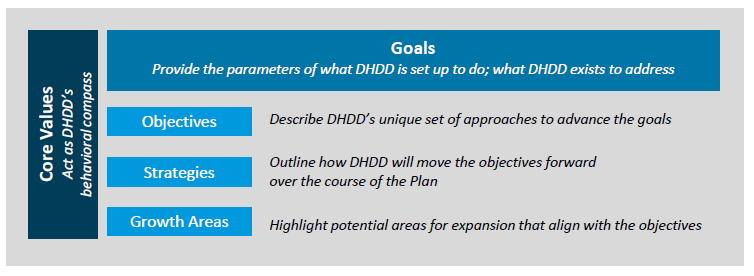DHDD Strategic Plan: Strategic Plan
Overview
Figure 5: Strategic Plan Components

Core Values – Act as DHDD’s behavioral compass
Goals – Provide the parameters of what DHDD is set up to do; what DHDD exists to address
Objectives – Describe DHDD’s unique set of approaches to advance the goals
Strategies – Outline how DHDD will move the objectives forward over the course of the Plan
Growth Areas – Highlight potential areas for expansion that align with the objectives
Core Values

DHDD’s core values outline its characteristics. We strive for these values to be engrained in all aspects of the organization and have a lifespan beyond the Strategic Plan.
Our goal is to reflect diversity, collaboration, respect, excellence, accountability, integrity, and innovation in all we do.
Goals
DHDD’s goals provide the parameters for what we set out to address. All our work and resources are dedicated to advancing these cross-cutting goals.
DHDD is committed to three goals:
- chart icon Build the evidence base to understand the needs of people with, or at risk for, disabilities
- arrow alt circle up icon Improve the health and developmental outcomes for people with, or at risk for, disabilities
- people icon Reduce the health inequities between people with and without disabilities
Objectives
The objectives depict the unique value DHDD adds in the human development and disability space. They not only support the cross-cutting goals, but also differentiate DHDD’s role and categorize its work. Work completed within the objectives can and should support other objectives.
For FY 2021–2025, DHDD will advance its goals through five objectives:
- sol icon Strengthen Surveillance & Research
- sol icon Enhance Programs & Systems
- sol icon Maximize Organizational Capacity & Resource Management
- sol icon Evaluate Programs & Interventions
- sol icon Enhance & Expand Strategic Partnerships & Communication
Strategies & Growth Areas
During the next 5 years, DHDD is committed to a set of strategies that align with the objectives stated above. The strategies describe where DHDD will focus and invest its time and resources for the next 5 years. DHDD will track a set of activities under each strategy that will describe the tactical actions needed to make progress in its Implementation Plan.
Growth areas, listed at the bottom of each objective section, are areas DHDD will track for expansion as resources are made available.
sol icon Strengthen Surveillance & Research

Strengthen surveillance of children and adults with, or at risk for, disabilities and conduct applied and epidemiological research in the area of disability and health.
Strategy 1.1. Expand surveillance data on children and adults with disabilities beyond prevalence to include screening, diagnosis, and health status
Strategy 1.2. Improve quality, timeliness, and availability of DHDD-collected data and other data systems
Strategy 1.3. Leverage existing disability and health data sources and linkages to reduce gaps in data availability for people with disabilities
Strategy 1.4. Conduct high-impact epidemiologic and applied research on disabilities and related health outcomes
Strategy 1.5. Test the effectiveness of interventions to develop and disseminate best practices
Strategy 1.6. Ensure that research findings are translated into programmatic applications and interventions that improve the health and well-being of people with, or at risk for, disabilities
Expand the Autism and Developmental Disabilities Monitoring (ADDM) Network to increase the geographic coverage and include increased surveillance of childhood disability
Expand surveillance of people with disabilities to better understand prevalence and health status
sol icon Enhance Public Health Programs & Health Systems

Enhance programs and systems to improve health and optimize care of people with, or at risk for, disabilities.
Strategy 2.1. Use surveillance and research data to inform child development and disability public health programming
Strategy 2.2. Increase and improve early identification, diagnosis, and referral for intervention of early childhood hearing loss, developmental disabilities, and mental health conditions
Strategy 2.3. Increase parent-engaged developmental monitoring within early childhood systems and programs
Strategy 2.4. Evaluate adaptations of public health programs to increase access to and utilization of services across functional disabilities
Strategy 2.5. Adopt innovative practices for effectively engaging healthcare providers to increase the reach of programs and policies for people with, or at risk for, disabilities
Strategy 2.6. Support health and well-being of children and people with, or at risk for, disabilities in public health emergencies
Evaluate impact of programs, services, and policies on outcomes of children and adolescents with, or at risk for, disabilities (healthcare transitions)
Address cultural and communication needs of populations to increase reach and impact of DHDD’s programmatic work
sol icon Maximize Organizational Capacity & Resource Management
Ensure optimization of DHDD’s resources and operational functions including its people, processes, and technology.
Strategy 3.1. Enable staff to deliver on DHDD priorities, programs, and activities through trainings and workforce development opportunities
Strategy 3.2. Identify and implement financial management processes and procedures that support operational efficiency
Strategy 3.3. Provide quality, timely, and constructive technical assistance to programs
Explore opportunities to innovate DHDD’s workforce management for the future
Integrate the use of new technology and data practices to advance DHDD’s operational impact
sol icon Evaluate Programs & Interventions
Evaluate program progress and identify opportunities for continuous improvement.
Strategy 4.1. Perform ongoing evaluation of key activities to ensure program outcomes are met and interventions are efficient and cost-effective
Identify and incorporate more comprehensive evaluation methodologies into project scopes
Explore and expand additional programs for evaluation
sol icon Enhance and Expand Strategic Partnerships & Communication

Strengthen current key partnerships, identify new relationships, and strategically utilize communications to advance DHDD’s work.
Strategy 5.1. Evaluate the impact and benefits of current partnerships
Strategy 5.2. Identify new partnerships and communication outlets to increase DHDD’s visibility, reach, and impact to inform and define the human development and disability landscape
Strategy 5.3. Identify shared priorities and opportunities for collaborative messaging with other CDC Offices, federal agencies, and national partners
Strategy 5.4. Foster ongoing collaboration and sharing of data and research with partners to inform the national discourse and promote policy change
Strategy 5.5. Improve communication strategies that address the needs of people with disabilities
Adopt innovative practices for engaging healthcare providers to increase the reach of programs and practices
Reduce communication barriers in research and implementation of evidence-based interventions for people with, or at risk for, disabilities